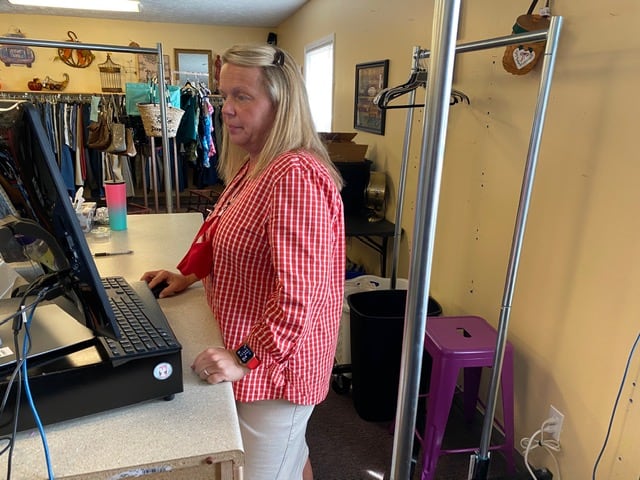- What is carpal tunnel syndrome?
- What are the symptoms of carpal tunnel syndrome?
- What is carpal release and how does it help carpal tunnel?
- What’s it like to have carpal release surgery?
- Is carpal release surgery right for you?
Jennifer spent longer than she’d like to remember struggling with typical symptoms of carpal tunnel syndrome: hand numbness, burning, and the inability to grasp and pick up items.
When she couldn’t take the discomfort anymore, she sought the help of Travis Clegg, M.D., a board-certified orthopedic surgeon, to diagnose and treat the condition.
After having the carpal tunnel release procedure, Jennifer says, “The biggest benefit of having this surgery with Dr. Clegg is that I’m pain free.”
What is Carpal Tunnel Syndrome?
Carpal tunnel syndrome is a type of median nerve compression in the hand. Swelling and irritation can cause the nerves to be compressed, causing pain, numbness, burning, and weakness in the hand and wrist, and sometimes even the forearm. Hand numbness and pain were two symptoms Jennifer experienced.
She says, “If I tried to read, my hand would go numb. It was awful.”
Inside the delicate structures of the human hand is a narrow passageway called the carpal tunnel. It is located on the palm side of the hand and surrounded by ligaments and bones. The median nerve, which starts in the arm and runs through the hand, goes through that tunnel, providing feeling to the thumb, index, middle, and part of the ring fingers. When that nerve is squeezed or pressed, the symptoms that we know as carpal tunnel can occur.
What Are the Symptoms of Carpal Tunnel Syndrome?
 The symptoms of carpal tunnel may start slow and progress. Typical symptoms include:
The symptoms of carpal tunnel may start slow and progress. Typical symptoms include:
- Burning, itching, tingling, or numbness in the palm, thumb, or fingers
- Shock-like jolts that move into the arms
- Tingling that radiates up your arm
- Weakness in the hand and trouble gripping normally
Those suffering with carpal tunnel syndrome say they notice their fingers falling asleep, or becoming numb at night when they lie down. Mornings are filled with tingling and numbness in the hands that may work up to your shoulder. Normal activities are affected. During the day you may have flare-ups that affect your work, recreational activities, or even normal household tasks. As the symptoms worsen, you may experience hand cramping and a reduction in grip strength in your hands.
Carpal tunnel prevents the median nerve from working the way it should. You’ll usually have less feeling in the fingers and lack coordination and strength for everyday tasks. That’s because the irritation and pressure surrounding the median nerve causes nerve impulses to slow, and that causes pain and loss of function.
What is Carpal Release and How Does it Help Carpal Tunnel?
Carpal tunnel release is a surgical procedure to cut through the ligament that has swelled and is pressing on the median nerve. This makes room for the nerve passing through the carpal tunnel and typically improves function and relieves pain and burning.
As a carpal tunnel patient, Jennifer had been experiencing the symptoms of carpal tunnel and was ready to do what was necessary to alleviate her pain. Dr. Clegg says, “We were able to do a carpal tunnel release. She had suffered from numbness; burning in the hands for years.”
Carpal tunnel release is often not the first treatment your doctor may recommend. Other treatments for carpal tunnel may include:
- Lifestyle changes
- Over-the-counter pain medications
- Physical therapy
- Steroid shots
- Wrist splints
When these treatments no longer combat the swelling, numbness, pain, and loss of function, carpal release may be the best option.
What’s it Like to Have Carpal Release Surgery?
 Carpal release is normally an outpatient surgery, meaning you’re released from the surgery facility within several hours of their procedure to begin recovery from the comfort of your home. This was true in Jennifer’s case. Dr. Clegg says, “We did a procedure where she didn’t even have to go under anesthesia, meaning she was actually awake for the procedure. We were able to do a local anesthetic and she went home later the same day.”
Carpal release is normally an outpatient surgery, meaning you’re released from the surgery facility within several hours of their procedure to begin recovery from the comfort of your home. This was true in Jennifer’s case. Dr. Clegg says, “We did a procedure where she didn’t even have to go under anesthesia, meaning she was actually awake for the procedure. We were able to do a local anesthetic and she went home later the same day.”
There are two types of carpal tunnel release. The first is the traditional method of making a small incision in the wrist to the surgery. There is also the endoscopic carpal tunnel release, where a small flexible tube with a camera is put into the wrist through a tiny incision. The camera helps guide the surgery as the doctor completes the procedure through a second small cut.
The studies say carpal tunnel release is widely recognized as an effective surgical treatment for idiopathic carpal tunnel syndrome, with an effectiveness rate of 75 to 90%.
After the surgery, the area is wrapped in a splint or heavy bandage. You will have pain medications and be encouraged to wiggle your fingers and keep the hand elevated while you’re sleeping to decrease any swelling.
After the surgery, Jennifer says, “All I had to do was rest for a few days and watch my lifting for maybe a couple of weeks.” Others who have the surgery may be required to attend physical therapy sessions to learn motion exercises to improve hand movement and regain strength.
Dr. Clegg says the results from carpal release surgery can be dramatic.
For Jennifer, Dr. Clegg says, “She was immediately better, and able to sleep through the night and function improved rapidly.”
Is Carpal Release Surgery Right for You?
Most people consider carpal release surgery in consultation with their doctor after other approaches no longer alleviate their pain and suffering. When the decision is made to undergo the procedure, the results can be life-changing.
The results Jennifer experienced were typical. Most patients experience a great deal of relief from the carpal release procedure. It helps to work with an experienced and caring orthopedic team.
Jennifer praised Dr. Clegg and his team for their professionalism and caring. She reported that the nurses and Dr. Clegg all called to check on her after the procedure. Jennifer says, “That’s an excellent team. They take care of their patients. They treat you like family.”
If you’re experiencing the symptoms of carpal tunnel, please don’t hesitate to talk with our team. Treatments are available that can get you back to doing the things you love.
